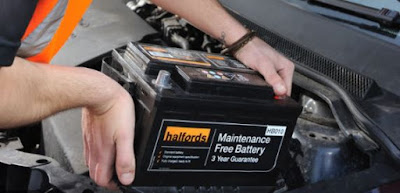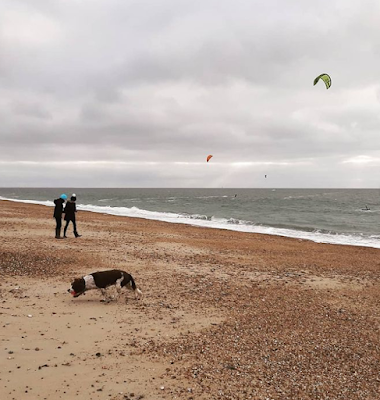08:00 Our big preoccupation today is getting our dud car battery replaced, and Halfords have a really slick system, it seems. Yesterday I got on their website and put in our car's registration number. They somehow knew it was an 8 year old Honda Jazz and they came up with 2 recommendations for our new battery, the cheaper one with a 3 year guarantee and the dearer one with a 5 year guarantee, so we decide to go for the dearer one, hoping that the new battery will see the car through to its end.
I also booked the cheapest time-slot, Saturday (today) 8am till 8 pm, which only costs £2 - I'm such a cheapskate haha!!! But quite early this morning, when Lois and I are still in bed, they email me with a narrower time slot - 11.30 am to 3.30 pm. And the guy will ring my mobile phone when he's on his way. To protect both us and their staff, there will be minimal contact, say Halfords, and we can even leave the car-key in a safe place, for the installer guy to pick up: we nominate our front porch. Simples!
a typical Halfords installer installing a new car battery
The guy actually comes about 1 pm when we are having lunch, and we give him a cheery wave as he picks up the car-key from our front porch. It only takes him 5-10 minutes to do the job, and he says the guarantee will be emailed to me - how marvellous!
This is what the internet is first and foremost for, in my opinion - to make sure you can get away with minimal contact with anybody working on your car!
Obviously what Lois and I are most afraid of is breaking down with a flat battery somewhere out in the sticks this coming winter.
We were a bit scared by a recent story in the comic strip put out by our favourite Danish cartoonist Morten Ingemann. Morten Ingemann is our favourite, because he tends to be interested in middle-aged and older, overweight, ugly people like us - the sort of people usually ignored by most cartoonists.
In the story, a couple have been found half-frozen together in a parked car at a drive-in cinema. They had apparently arrived early to see the feature film "Vinterlukket", and were trying to keep warm while they waited. I've never heard of the film, and some research on the internet fails to turn up the details. I try to search on the equivalent English title "Closed for Winter", but again I find nothing - damn!
It's only a fictional story of course, but it makes you think what could happen to us!
We're neither of us very practical people, especially me (!), and we rely a lot on tips we garner from the influential American news website, Onion News, to help us cope with some of life's worst hazards, to put it mildly!
And it's not just in a broken down car that we'll need to keep warm this coming winter. If the heating breaks down in our home, that can be just as dangerous!
Millions of
people are looking for ways to keep warm as temperatures plunge across the
nation. Here are The Onion’s tips for staying comfortable during the coldest
days of winter:
1.
Body
heat is the best kind of warmth. Simply cut your chest open and place your
appendages inside where it’s nice and toasty.
2.
Whenever
coming inside from the freezing outdoors, remember to shiver and say “brrr.”
3.
Prevent
heat from escaping by putting a hat on your thermostat.
4.
For the
toastiest spot in the house, head to the fireplace and crawl under burning
logs.
5.
Develop
a thick layer of protective blubber through millions of years of evolution.
6.
Keep
heat in your body by tightly packing all orifices with fiberglass insulation.
7.
Adopt
several dogs from the local shelter, bring them home, and snuggle up next to
them until you are heated throughout. Return them when finished.
8.
Crouch
low to the ground to cover both legs with your feathers.
Plenty of good advice here, that's for sure! I've just printed the Onion's Winter Guide out and stuck it up on the wall so that we can consult it from time to time. And fingers crossed, Lois and I will still be around next spring to get our anti-COVID vaccination!
13:30 We have a cup of tea on the sofa and I look at my smartphone. Our daughter Sarah, who lives just outside Perth, Australia with Francis and their 7-year-old twins Lily and Jessie is spending the weekend in the Margaret River Region just south of Perth. Sarah sends us a charming picture of herself taken in the Busselton area - Busselton boasts the longest pier in the Southern Hemisphere.
Sarah today in the area of Busselton, Western Australia
a nearby café, where some of the seating consists of "swing-seats", which the twins loved.
But is this a good idea? Sounds a bit nauseous to Lois and me, but perhaps we're getting old
- oh dear!!!!
Lois and I visited the Busselton and surrounding area with Sarah's family in 2018. We all had lunch at the Elephant Café on the beach, we remember fondly. Sarah and family have visited the café again this weekend, which is nice.
Flashback to April 2018: me, Francis, Sarah, Lily and Jessie
at the Elephant Café on Gnarabup Beach, Margaret River Region,
Western Australia - happy days!!!!!
13:45 Meanwhile our other daughter, Alison, who lives in Haslemere, Surrey, together with Ed and their 3 children Josie (14), Rosalind (12) and Isaac (10), are in the Hayling Island area of Hampshire today. Alison put a charming picture of the 2 girls and the family's Danish dog Sika up on Instagram, which is nice.
Josie and Rosalind, 2 of our grandchildren, on the beach at Hayling Island this morning
with Sika, the family's Danish dog (with a ball in his mouth)
19:00 We settle down on the sofa to watch a bit of TV, an interesting documentary (3rd part of 3) of "Surviving the Stone Age".
In tonight's final episode, the "tribe" of mixed-sex Anglo-American primitive crafts-teachers finally manage to shoot a big deer, which they comprehensively use for food and for making tools etc, just as people did in the Stone Age.
It's been an interesting series. The only possible downside is that the tribe's members are pretty quiet people, rather introverted - this is nice, and perhaps this is what you'd expect from people who like to go out and live in the wild. But the disadvantage is that Lois and I don't feel we have really got to know some of them that well.
But it's been fascinating to hear little snippets every so often from the narrator about human evolutionary history. In tonight's programme, the tribe, having shot the deer with bow and arrow, do a pit-roast of their first piece of venison, their first meat meal in 3 to 4 weeks of the experiment - they bury the meat plus a pile of red-hot stones for 12 hours underground.
Apparently the ability to cook food meant that our ancestors could evolve smaller teeth, because it wasn't so tough any more to do all that chewing - my god! And their liking for the bone marrow of their prey would have helped their brains to develop. Fascinating!
Stones heated up in a fire and plunged into water was also the way people heated water up in those times apparently, although they obviously wouldn't have drunk Earl Grey tea like Lois and I do today - that came much, much later.
21:00 We continue to watch TV, the latest in Alice Roberts's new series on Britain's Most Historic Towns. Tonight's episode is all about Portsmouth.
An interesting programme. Portsmouth was originally chosen as the Royal Navy's premier naval base, because of its position - close to the English Channel but protected from the worst of the weather and from potential enemies by the nearby Isle of Wight.
Lois and I didn't know that 103,000 British sailors died during the Napoleonic Wars of 200 years ago, but only 6,000 of these actually died in battle. The remainder died of diseases, especially sexually transmitted diseases.
The district of Portsmouth that ran from the docks to the town-centre was known as "Sailortown" - at any one time there were about 3,500 sailors living there: an area packed with taverns and lodgings-houses, plus 300 brothels - my god!
Many contemporary prints aimed to depict life in Sailortown and similar areas around Britain's coasts.
contemporary prints of life in Sailortown and similar areas around Britain's coasts
It all looks very jolly, but it's believed, however, that life wasn't always as jolly as the prints suggest, however, either for the men or the prostitutes. And sexually transmitted diseases were rife.
Mainly to protect the health of Britain's sailors, Parliament passed a number of "Contagious Diseases Acts", starting in 1864, under which the police could imprison prostitutes for an average of 50 days. On their release these women were issued with a Government "Health Certificate", but many used these as a way to attract custom over and above their competitors.
My god - what a crazy world we live in !!!!!
22:00 We go to bed - zzzzzzzzzz!!!!!






















No comments:
Post a Comment